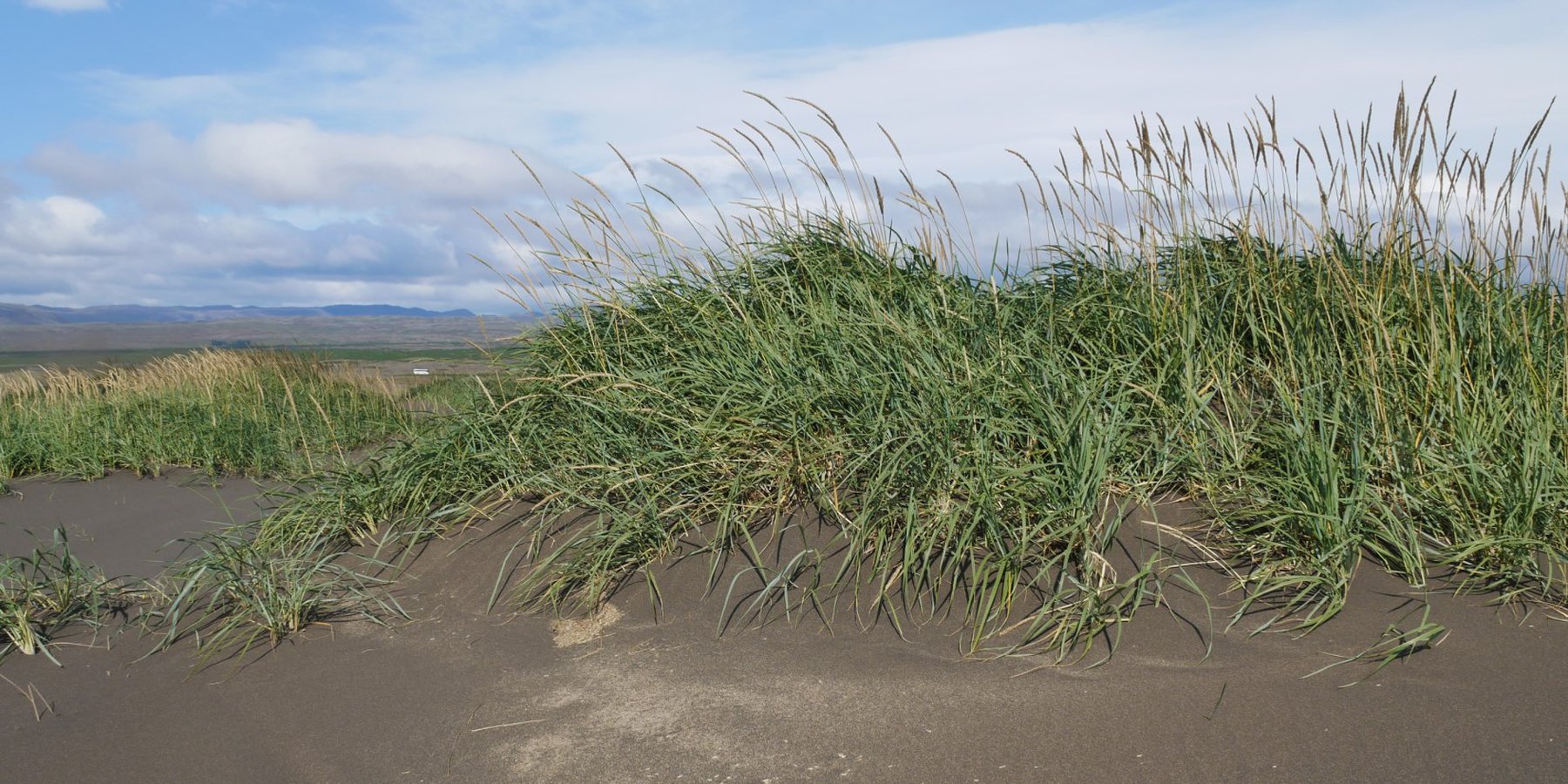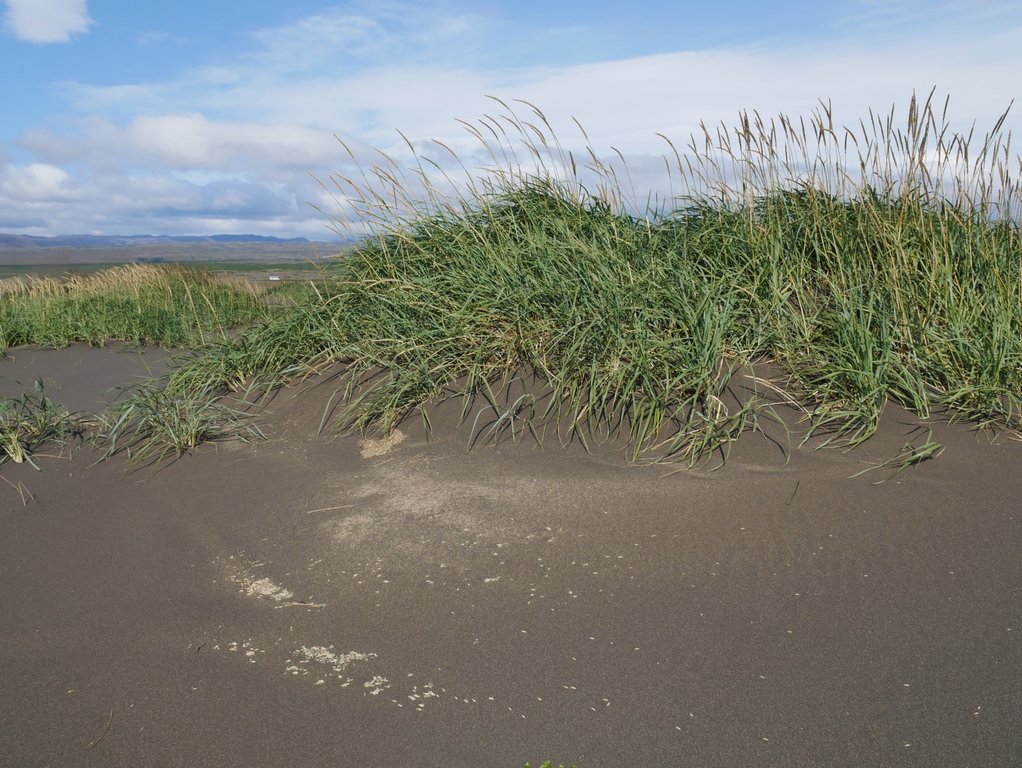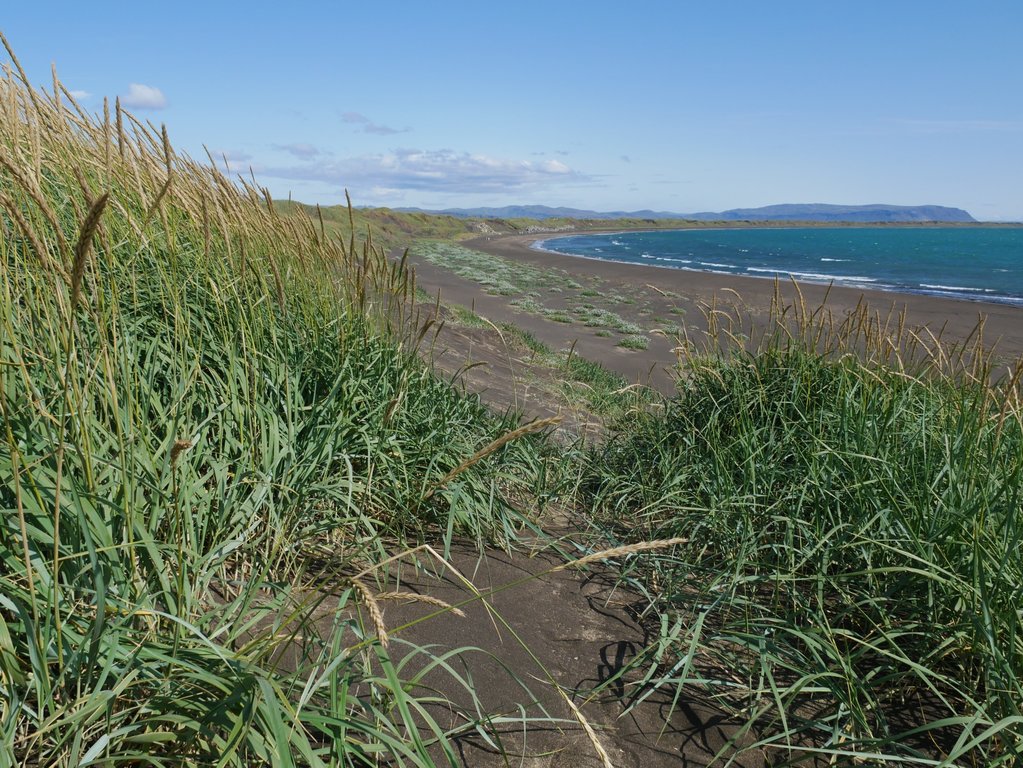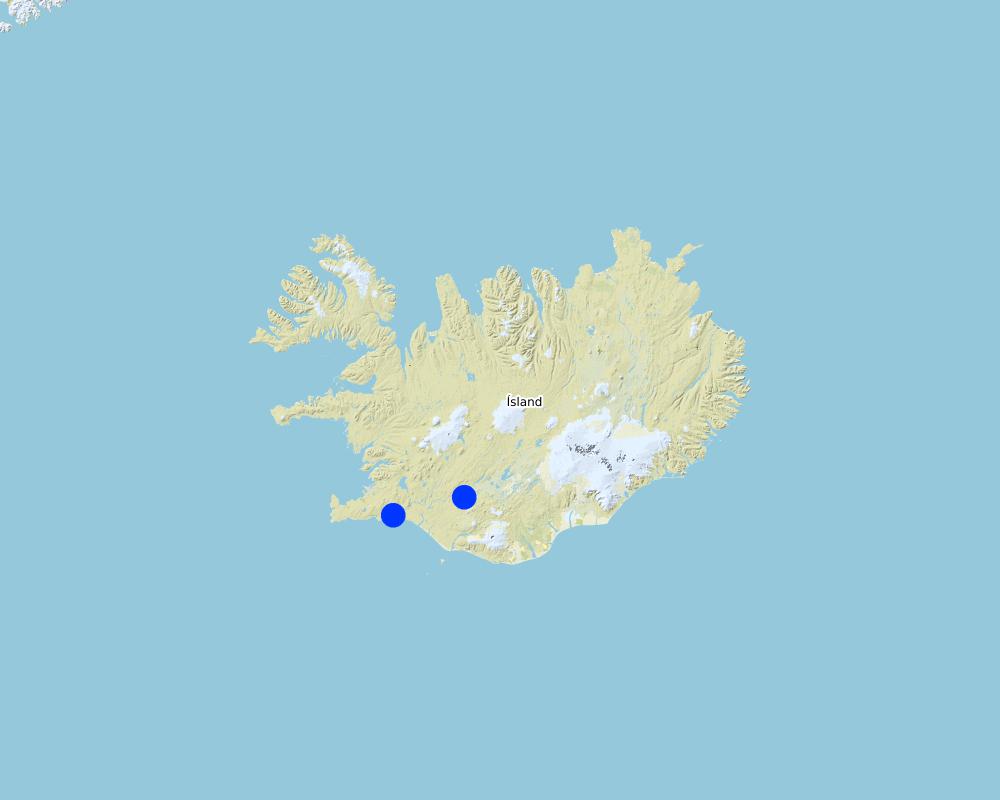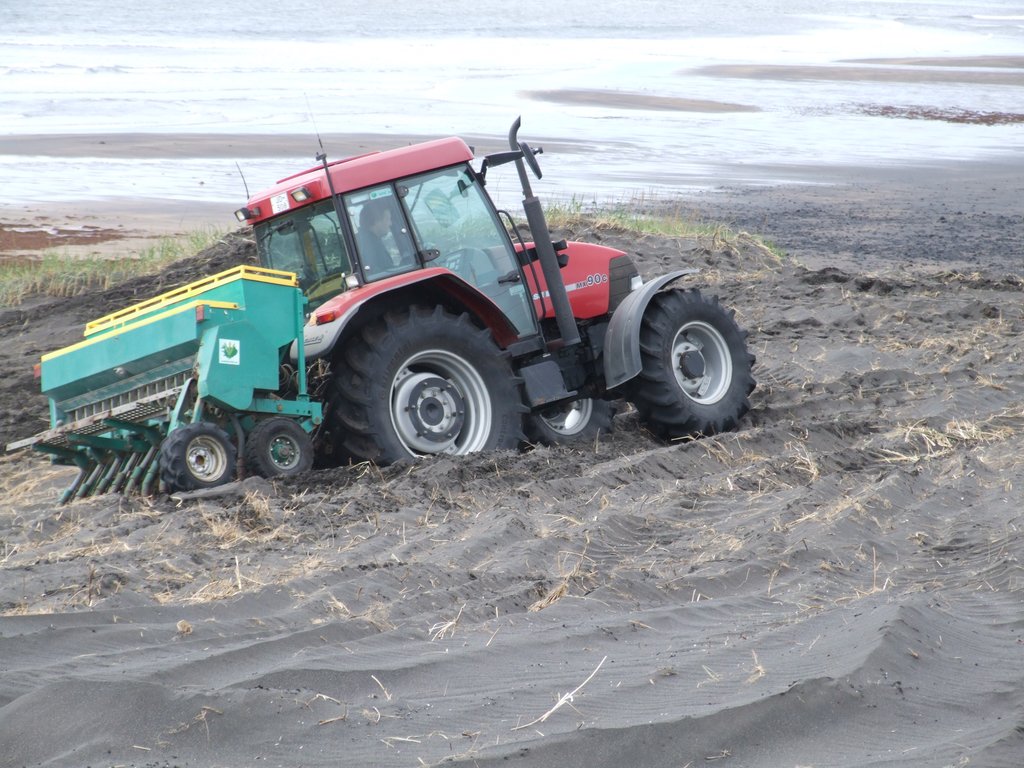Seeding lyme grass for land reclamation and to protect the soil against wind erosion [冰岛]
- 创建:
- 更新:
- 编制者: Jan Reichert
- 编辑者: Hanspeter Liniger
- 审查者: Hanspeter Liniger
technologies_5756 - 冰岛
查看章节
全部展开 全部收起1. 一般信息
1.2 参与该技术评估和文件编制的资源人员和机构的联系方式
关键资源人
SLM专业人员:
Runólfsson Sveinn
Soil Conservation Service of Iceland
冰岛
1.3 关于使用通过WOCAT记录的数据的条件
编制者和关键资源人员接受有关使用通过WOCAT记录数据的条件。:
是
1.4 所述技术的可持续性声明
这里所描述的技术在土地退化方面是否存在问题,导致无法被认为是一种可持续的土地管理技术?:
否
2. SLM技术的说明
2.1 技术简介
技术定义:
Lyme grass is is sown by machines for revegetation in sandy areas to increase the vegetation cover, to capture and stabilise the moving sand. The extensive root system allows the plant to grow in sandy underground and thus protects the soil from extensive wind erosion.
2.2 技术的详细说明
说明:
Lyme grass (Leymus arenarius) is a native pioneer plant in Iceland. Due to its spreading, rhizomatous habit it survives and spreads in sand and even in blown sand. The sand can be captured and stabilised, and vegetation cover increases. In this way, new vegetation cover comprising other plants can further develop. Therefore, this plant is used on degraded land with sandy soils to restore and hinder it from further erosion. Wind erosion can be minimized or stopped. Lyme grass protects and prevents the soil from being blown away and from causing damage on- and offsite. For these reasons, it has been applied in various locations throughout Iceland.
Lyme grass is seeded in with machinery in early spring or late autumn over a complete area. Before planting, the seeds have to be treated in order to go through the drilling machine. These seeds are harvested with specialized machinery in September. In order to promote growth and spread, the plants are supported with fertilizer in the four years after application. Normally this activity is carried out in early spring. The use of imported fertilizer is necessary, but quite expensive. Because lyme grass is sensitive to grazing, a fence is often built to protect the area from livestock. In more advanced restored land, seasonally controlled grazing in the summer with sheep can take place again. Sandy areas remain protected because of their vulnerability to wind erosion.
Once planted, lyme grass spreads by itself through rhizomes, and by producing large amounts of seeds every year. It is winter hardy - and copes well with droughts because of its deep roots. Lyme grass is highly appreciated because it brings clear long-term improvement onsite and provides offsite benefits. Onsite, Lyme grass improves soil and vegetation cover and minimizes evaporation from the soil surface. In addition, surface runoff is minimized. Less sediment is transported with the wind and damage to the neighbouring field or private and public infrastructure is minimised offsite. Furthermore, lyme grass can also store large quantities of carbon. Because of its many positive features, this technology is being adopted in many places.
2.3 技术照片
2.5 已应用该技术的、本评估所涵盖的国家/地区/地点
国家:
冰岛
区域/州/省:
South of Iceland
有关地点的进一步说明:
Thorlákshöfn and Hekla area
具体说明该技术的分布:
- 均匀地分布在一个区域
如果不知道精确的区域,请注明大致覆盖的区域:
- 10-100 平方千米
技术现场是否位于永久保护区?:
是
如果是,请具体说明:
Fences protect the Lyme grass from grazing by sheep.
注释:
Lyme grass is very sensitive to grazing.
Map
×2.6 实施日期
如果不知道确切的年份,请说明大概的日期:
- 10-50年前
2.7 技术介绍
详细说明该技术是如何引入的:
- 在实验/研究期间
- 通过项目/外部干预
3. SLM技术的分类
3.1 该技术的主要目的
- 减少、预防、恢复土地退化
- 结合其他技术保护流域/下游区域
- 保持/提高生物多样性
- 降低灾害风险
3.2 应用该技术的当前土地利用类型
同一土地单元内混合使用的土地::
否

牧场
粗放式放牧:
- 经营牧场
集约放牧/饲料生产:
- 收割和携带/零放牧
动物类型:
- 马
- 绵羊
是否实行作物与牲畜的综合管理?:
否
产品和服务:
- 肉类
- 毛料
3.3 由于技术的实施,土地使用是否发生了变化?
由于技术的实施,土地使用是否发生了变化?:
- 是(请在技术实施前填写以下有关土地利用的问题)
同一土地单元内混合使用的土地::
否

其它
具体说明:
Protected area
注释:
Because the lyme grass is very sensitive to grazing, grazing is excluded in a first step. After reclamation, the land can be used again for controlled grazing during the summer months. Sandy areas remain protected because of their vulnerability to wind erosion. For rehabilitation, lyme grass can be combined with birch tree planting.
3.4 供水
该技术所应用土地的供水:
- 雨养
注释:
There are large deposits of groundwater in the area around Thorlákshöfn.
3.5 该技术所属的SLM组
- 改良的地面/植被覆盖
- 减少基于生态系统的灾害风险
3.6 包含该技术的可持续土地管理措施

植物措施
- V2:草和多年生草本植物
注释:
Could be combined with birch tree planting.
3.7 该技术强调的主要土地退化类型

土壤风蚀
- Et:表土流失
- Ed:风蚀风积
- Eo:场外劣化效应
3.8 防止、减少或恢复土地退化
具体数量名该技术与土地退化有关的目标:
- 减少土地退化
- 修复/恢复严重退化的土地
4. 技术规范、实施活动、投入和成本
4.1 该技术的技术图纸
技术规范(与技术图纸相关):
completly cover ground
seeded with machinery
seed has to be treated in order to go through the drilling machinery
100 kg per ha and add fertilizer
作者:
Sveinn Runólfsson
4.2 有关投入和成本计算的一般信息
具体说明成本和投入是如何计算的:
- 每个技术区域
注明尺寸和面积单位:
Project costs in Thorlákshöfn
其它/国家货币(具体说明):
ISK
如相关,注明美元与当地货币的汇率(例如1美元=79.9巴西雷亚尔):1美元=:
138.0
4.3 技术建立活动
| 活动 | 时间(季度) | |
|---|---|---|
| 1. | seeding and topdressing with fertelizer in one operation | early spring time, possible late autumn |
| 2. | harvest seeds by specialized machinery | September |
4.4 技术建立所需要的费用和投入
| 对投入进行具体说明 | 单位 | 数量 | 单位成本 | 每项投入的总成本 | 土地使用者承担的成本% | |
|---|---|---|---|---|---|---|
| 其它 | Seeding lyme grass | ha | 1.0 | 203539.0 | 203539.0 | |
| 技术建立所需总成本 | 203539.0 | |||||
| 技术建立总成本,美元 | 1474.92 | |||||
4.5 维护/经常性活动
| 活动 | 时间/频率 | |
|---|---|---|
| 1. | spreading fertelizer | early spring time once a year |
4.6 维护/经常性活动所需要的费用和投入(每年)
| 对投入进行具体说明 | 单位 | 数量 | 单位成本 | 每项投入的总成本 | 土地使用者承担的成本% | |
|---|---|---|---|---|---|---|
| 肥料和杀菌剂 | repeated ferilizer 2. year | ha | 1.0 | 19000.0 | 19000.0 | |
| 肥料和杀菌剂 | repeated ferilizer 3. year | ha | 1.0 | 19000.0 | 19000.0 | |
| 肥料和杀菌剂 | repeated ferilizer 4. year | ha | 1.0 | 19000.0 | 19000.0 | |
| 技术维护所需总成本 | 57000.0 | |||||
| 技术维护总成本,美元 | 413.04 | |||||
4.7 影响成本的最重要因素
描述影响成本的最决定性因素:
workers, seeds, fertilizer, machinery
5. 自然和人文环境
5.1 气候
年降雨量
- < 250毫米
- 251-500毫米
- 501-750毫米
- 751-1,000毫米
- 1,001-1,500毫米
- 1,501-2,000毫米
- 2,001-3,000毫米
- 3,001-4,000毫米
- > 4,000毫米
农业气候带
- 半湿润
- 半干旱
5.2 地形
平均坡度:
- 水平(0-2%)
- 缓降(3-5%)
- 平缓(6-10%)
- 滚坡(11-15%)
- 崎岖(16-30%)
- 陡峭(31-60%)
- 非常陡峭(>60%)
地形:
- 高原/平原
- 山脊
- 山坡
- 山地斜坡
- 麓坡
- 谷底
垂直分布带:
- 0-100 m a.s.l.
- 101-500 m a.s.l.
- 501-1,000 m a.s.l.
- 1,001-1,500 m a.s.l.
- 1,501-2,000 m a.s.l.
- 2,001-2,500 m a.s.l.
- 2,501-3,000 m a.s.l.
- 3,001-4,000 m a.s.l.
- > 4,000 m a.s.l.
说明该技术是否专门应用于:
- 不相关
5.3 土壤
平均土层深度:
- 非常浅(0-20厘米)
- 浅(21-50厘米)
- 中等深度(51-80厘米)
- 深(81-120厘米)
- 非常深(> 120厘米)
土壤质地(表土):
- 粗粒/轻(砂质)
土壤质地(地表以下> 20厘米):
- 粗粒/轻(砂质)
表土有机质:
- 低(<1%)
5.4 水资源可用性和质量
地下水位表:
< 5米
地表水的可用性:
中等
水质(未处理):
良好饮用水
水质请参考::
地下水
水的盐度有问题吗?:
是
具体说明:
in sites along the coast, soils/ sand can be saline
该区域正在发生洪水吗?:
否
5.5 生物多样性
物种多样性:
- 低
栖息地多样性:
- 低
5.6 应用该技术的土地使用者的特征
定栖或游牧:
- 定栖的
生产系统的市场定位:
- 商业/市场
非农收入:
- 收入的10-50%
相对财富水平:
- 丰富
个人或集体:
- 团体/社区
- 员工(公司、政府)
机械化水平:
- 机械化/电动
性别:
- 女人
- 男人
土地使用者的年龄:
- 中年人
5.7 应用该技术的土地使用者使用的平均土地面积
- < 0.5 公顷
- 0.5-1 公顷
- 1-2 公顷
- 2-5公顷
- 5-15公顷
- 15-50公顷
- 50-100公顷
- 100-500公顷
- 500-1,000公顷
- 1,000-10,000公顷
- > 10,000公顷
这被认为是小规模、中规模还是大规模的(参照当地实际情况)?:
- 中等规模的
5.8 土地所有权、土地使用权和水使用权
土地所有权:
- 州
- 社区/村庄
土地使用权:
- 社区(有组织)
- 个人
用水权:
- 自由进入(无组织)
土地使用权是否基于传统的法律制度?:
是
5.9 进入服务和基础设施的通道
健康:
- 贫瘠
- 适度的
- 好
教育:
- 贫瘠
- 适度的
- 好
技术援助:
- 贫瘠
- 适度的
- 好
就业(例如非农):
- 贫瘠
- 适度的
- 好
市场:
- 贫瘠
- 适度的
- 好
能源:
- 贫瘠
- 适度的
- 好
道路和交通:
- 贫瘠
- 适度的
- 好
饮用水和卫生设施:
- 贫瘠
- 适度的
- 好
金融服务:
- 贫瘠
- 适度的
- 好
6. 影响和结论性说明
6.1 该技术的现场影响
社会经济效应
水资源可用性和质量
饮用水的可用性
饮用水的质量
其它社会经济效应
land price/lease
社会文化影响
健康状况
注释/具体说明:
Less sediment in the air during windstorms due to increased ground cover and therefore fewer health consequences.
文化机会
娱乐机会
社区机构
国家机构
SLM/土地退化知识
生态影响
水循环/径流
水量
水质
水的回收/收集
地表径流
地下水位/含水层
蒸发
土壤
土壤水分
土壤覆盖层
土壤流失
养分循环/补给
土壤有机物/地下C
生物多样性:植被、动物
植被覆盖
生物量/地上C
植物多样性
动物多样性
栖息地多样性
减少气候和灾害风险
碳和温室气体的排放
注释/具体说明:
The lyme grass can store large amounts of carbon.
风速
6.2 该技术的场外影响已经显现
水资源可用性
下游洪水
下游淤积
地下水/河流污染
缓冲/过滤能力
风力搬运沉积物
对邻近农田的破坏
对公共/私人基础设施的破坏
温室气体的影响
6.3 技术对渐变气候以及与气候相关的极端情况/灾害的暴露和敏感性(土地使用者认为的极端情况/灾害)
气候有关的极端情况(灾害)
气象灾害
| 该技术是如何应对的? | |
|---|---|
| 局地风暴 | 好 |
气候灾害
| 该技术是如何应对的? | |
|---|---|
| 干旱 | 好 |
6.4 成本效益分析
技术收益与技术建立成本相比如何(从土地使用者的角度看)?
短期回报:
积极
长期回报:
非常积极
技术收益与技术维护成本/经常性成本相比如何(从土地使用者的角度看)?
短期回报:
积极
长期回报:
非常积极
6.5 技术采用
- > 50%
在所有采用这项技术的人当中,有多少人是自发的,即未获得任何物质奖励/付款?:
- 0-10%
6.6 适应
最近是否对该技术进行了修改以适应不断变化的条件?:
否
6.7 该技术的优点/长处/机会
| 土地使用者眼中的长处/优势/机会 |
|---|
| Seeding lyme grass increases the vegetation cover, stabalize the sand and sucesfully protects against wind erosion. |
| 编制者或其他关键资源人员认为的长处/优势/机会 |
|---|
| Seeding lyme grass increases the vegetation cover, stabalize the sand and successfully protects against wind erosion. |
| The creeping horizontal roots allows the lyme grass to spread, establish and stabilize the sand dunes and can therefore protect infrastructure. |
| The long roots allow the lyme grass in contrast to other plants to survive in sandy grounds. |
| Lyme grass sequests enourmous amount of carbon. |
6.8 技术的弱点/缺点/风险及其克服方法
| 土地使用者认为的弱点/缺点/风险 | 如何克服它们? |
|---|---|
| A lot of expensive imported fertelizer is needed for this technology. | Instead of imported fertilizer, manure can be used (but this way more expensive). |
| Lyme grass is highly sensitve to grazing. |
| 编制者或其他关键资源人员认为的弱点/缺点/风险 | 如何克服它们? |
|---|---|
| Lyme grass is highly sensitive to grazing. | The lyme grass is protected by building fences or implementing controlled grazing. |
| A lot of expensive imported fertelizer is needed for this technology. |
7. 参考和链接
7.1 信息的方法/来源
- 实地考察、实地调查
- 与土地使用者的访谈
- 与SLM专业人员/专家的访谈
(现场)数据是什么时候汇编的?:
01/08/2019
7.3 链接到网络上的相关信息
标题/说明:
Webpage Soil Conservation Service of Iceland
URL:
https://land.is/english/
链接和模块
全部展开 全部收起链接
无链接
模块
无模块


